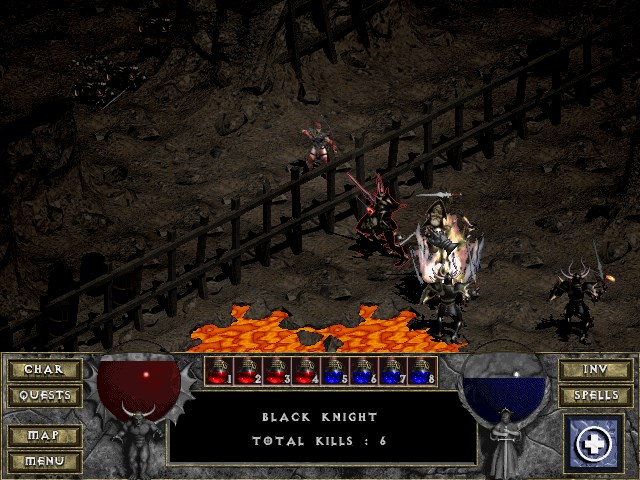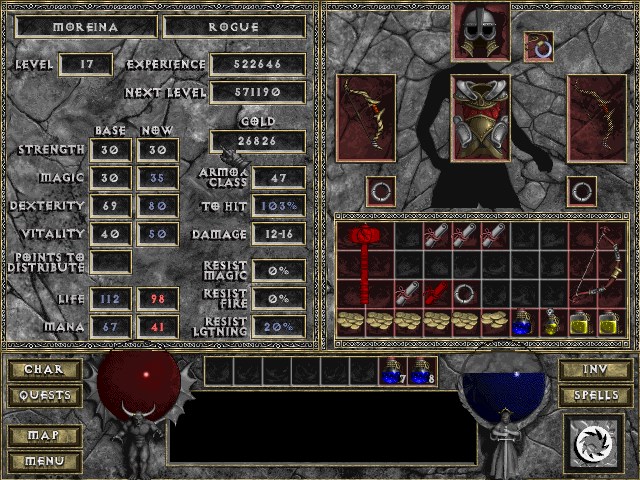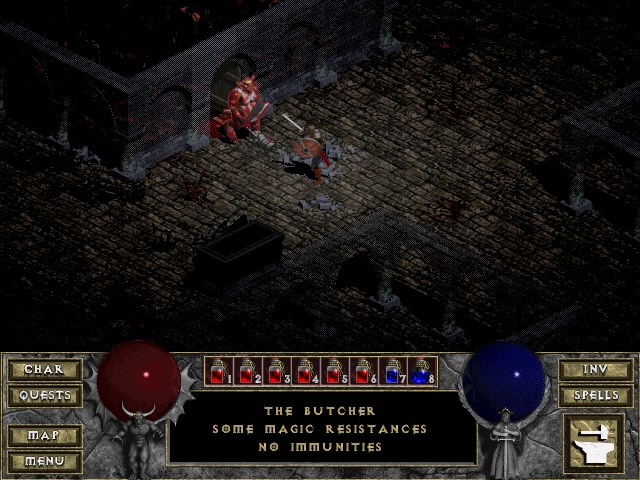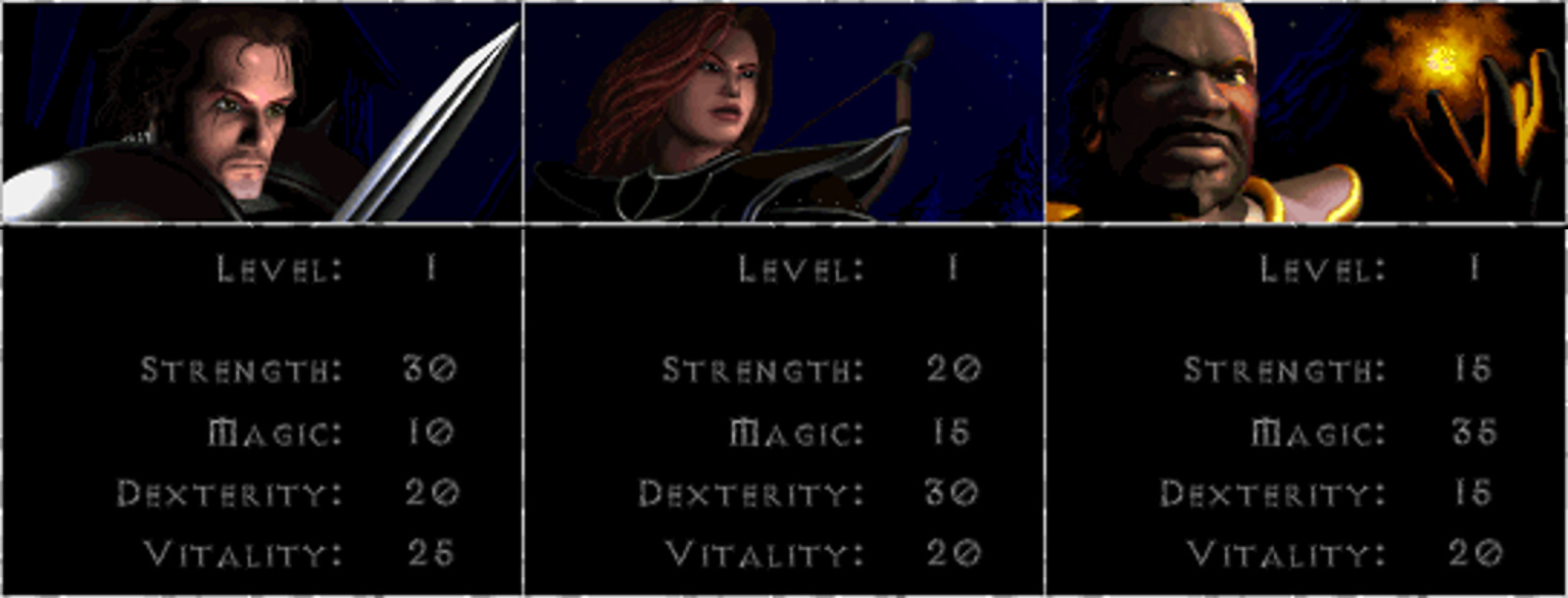Diablo I
< Back



| Quick Info | |
|---|---|
| Mods available? | Yes |
| Year released | 1997 |
| Available from | GoG
Battlenet |
| Category | Rpg |
| Time to Beat | 13.5 Hours |
| Played? | Yes |
| Game length provided by HowLongToBeat |
|
Diablo is an action role-playing game developed by Blizzard North and released in 1997. Set in and below the town of Tristam, the player selects one of three classes and builds a character to crawl into progressively more dangerous dungeons. A game that birthed a genre, and contributed to the success of Blizzard in the early years, this game is a must play for those who wish to understand where ARPGs started.
The game is available from the Battlenet store or Good Old Games and has some modding support, with additional content available through a single expansion developed by Sierra On-line. When the games new content to see is exhausted, players came up with the idea of Diablo 'variants', centered around the idea of creating a character with specific restrictions and goals, in the vein of tabletop Dungeons and Dragons.
Why should this game be played?
Diablo is an interesting game that contains parts of several different genres that are common today that were not fully matured back in the late 90s. Originally conceived as a turn-based more strategical roguelike game, the decision to move to a real-time system was made late into development. The tactical emphasis on character positioning is still there and shows throughout the game. Roguelike elements exist across playthroughs, with procedural levels and only certain quests available in any given playthrough.
The game allows a player to pick one of three classes, the traditional holy trinity of warrior / mage / rogue but does not pigeon hole the player into sticking within the confines of their chosen class. All equipment and spells can be used by all classes, only restricted by the stats allocated as a character levels up. While most 'optimal' builds may not stray far from the archetype selected, even in those builds the ability for all classes to use spells provides additional utility and flexibility. This became even more interesting when optimal playstyles are ignored and challenges or roleplaying instead became the focus.
 In each game there are 16 procedurally generated levels to clear, starting within the Tristam Cathedral, moving through the Catacombs and Caves below the Cathedral and eventually brining the player into Hell itself. Additional replayability is available through 3 difficulties, with characters able to progress through normal, nightmare and hell modes. Throughout the dungeon crawl, there is equipment to be found, stats to allocate, spells to learn and shrines (at your own risk) to activate.
In each game there are 16 procedurally generated levels to clear, starting within the Tristam Cathedral, moving through the Catacombs and Caves below the Cathedral and eventually brining the player into Hell itself. Additional replayability is available through 3 difficulties, with characters able to progress through normal, nightmare and hell modes. Throughout the dungeon crawl, there is equipment to be found, stats to allocate, spells to learn and shrines (at your own risk) to activate.
There are three levels of equipment to be found: normal, magic and unique. Normal equipment provides no extra stats beyond damage on weapons or armor on clothing. Magic equipment can have up to two modifiers, with some affixes that will be well remembered by players (like 'of the whale' or 'obsidian ring of the zodiac'). The final tier of equipment available is unique items, these being items that have a predefined design but may have values that roll within a range. Coupling the equipment that can be found with the fact that players can choose their own stat allocation, being provided 5 points to put into strength, dexterity, magic or vitality allows for a decent amount of player agency and the ability to customize their class.
The music, voice work, environments and models are all very well done for the time. With many of the monster models in game being initially made in clay and scanned in to be turned into sprites providing a really unique look to the bestiary. Overall this is an amazing dungeon crawl that is worth the time for all folks interested in the ARPG and RPG genres - even if it's only for a single playthrough to see a piece of computer gaming history.
Where to get the game
D1 is available through both GoG and the Battlenet Store, with the GoG version being part of the GOG Preservation Program
Hellfire Expansion
The Hellfire expansion to D1 was developed by Synergistic Software, a division of Sierra. This was due to a strange set of circumstances where Blizzard North and Sierra were both owned by Davidson & Associates (an educational software developer) at the time. Blizzard North was busy working on Diablo II, so Synergistic was tapped to make the expansion for D1.
The expansion introduces a new character class, the monk, along with two new dungeons tilesets to explore. There are also two additional classes that can be accessed through some file editing better explained by this Pure Diablo article.
Available Mods
There is a large selection of mods for Diablo that update the game for play on modern systems, allowing for higher resolution and other changes to the base presentation. Additionally there are full-scale overhauls for the game. Links below in the Game Resources section.
Mod installation
Modding Diablo I is straightforward, as most of the total conversion mods such as Bezelbub, Devilutionx or The Hell utilize the Diablo MPQ (game info file) and just require that file to be copied into the directory where the mod has been unzipped. From there, the mods provide an executable file to launch the game. Additionally there is a lightweight mod manager called EQUINE that players can download to allow for multiple instances of Diablo I to be managed and easily supported.
Variants
Variants are one of my fondest memories of Diablo 1. Once the game has been beaten with a normal character, subsequent playthroughs can have some added challenge by embracing a role-playing approach. Variants were borne out of a necessity to stretch the enjoyment of a single game as far as it could go, and to provide additional challenges to a run. Besides just a role-playing approach, the idea of an Ironman mode was also created. Having players see how far they could get through the dungeons of Tristam without returning to town and utilizing the resources of the shopkeepers.
Reading Materials
Fiction or non-fiction, there is a host of reading materials covering the development of Diablo or set within the universe. I can't vouch for the quality of the fictional writing, as I've not had the chance to read any but I've really enjoyed the nonfiction I've collected and read.
The books Stay Awhile and Listen by David L. Craddock cover the development of both Diablo I and II. The history of Blizzard North is covered, along with the wild ride the company experienced while creating these hit games. Well worth the read!
For more design focused reading, the original Diablo I game design document is available online, outlining David Breviks original intent to create a turn based hack-n-slash RPG game, mixing Xcom with the atmosphere of something closer to the Ultima series.
There are a dozen novels set in the world of Sanctuary, with a few directly covering the events that occurred within Tristram.Along with the novels, a bunch of graphic novels, art books and the like are also available from other sources.
Additional Resources
| Resource | Link | Description |
|---|---|---|
| Game Info | Diablo I Wiki |
D1 wiki containing info on the game, classes, etc... |
| Character Guides | Bolty's Warrior Guide |
A classic in-depth character guide for the warrior class |
| Rogue 101 Guide |
A good overview of the Rogue class for Diablo 1 | |
| Flux's Mage Guide |
Another super in-depth guide to playing a mage. | |
| Hellfire Monk Guide |
A short but useful guide on the Monk class from the Hellfire expansion | |
| Variants | Realms Beyond |
THE classic variants site. Containing guides, stories and recounts of adventures. |
| Ironman Rules |
One authors take on the Ironman ruleset that many Diablo players followed for a challenge run. | |
| Mods | DevilutionX |
DevilutionX is a port of Diablo and Hellfire that strives to make it simple to run the game while providing engine improvements, bug fixes and optional QoL changes. |
| Diablo I HD Mod - Bezelbub |
Bezelbub is a full conversion mod that also brings Diablo I to modern resolutions and wide-screen monitors. Featuring two new classes, new locations, new items and four additional difficulties. | |
| Diablo: The Hell |
Another total conversion and modernization mod for Diablo I. This mod includes five new classes, new skills, new items, and restored cut content from the original game. |
